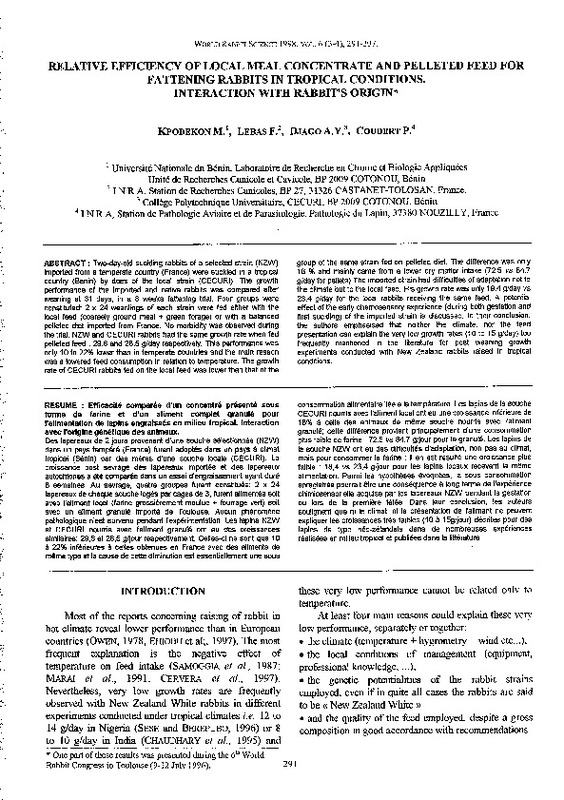JavaScript is disabled for your browser. Some features of this site may not work without it.
Buscar en RiuNet
Listar
Mi cuenta
Estadísticas
Ayuda RiuNet
Admin. UPV
RELATIVE EFFICIENCY OF LOCAL MEAL CONCENTRATE AND PELLETED FEED FOR FATTENING RABBITS IN TROPICAL CONDITIONS. INTERACTION WITH RABBIT'S ORIGIN""
Mostrar el registro sencillo del ítem
Ficheros en el ítem
| dc.contributor.author | Kpodekon, M.
|
|
| dc.contributor.author | Lebas, F.
|
|
| dc.contributor.author | Djago, A.Y.
|
|
| dc.contributor.author | Coudert, P.
|
|
| dc.date.accessioned | 2011-03-14T12:28:05Z | |
| dc.date.available | 2011-03-14T12:28:05Z | |
| dc.date.issued | 1998 | |
| dc.identifier.issn | 1257-5011 | |
| dc.identifier.uri | http://hdl.handle.net/10251/10330 | |
| dc.description.abstract | [EN] Two-day-old suckling rabbits of a selected strain (NZW) imported from a temperate country (France) were suckled in a tropical country (Benin) by does of the local strain (CECURI). The growth performance of !he imported and native rabbits was compared after weaning at 31 days, in a 8 weeks fattening trial. Four groups were constituted: 2 x 24 weanlings of each strain were fed either with the local feed (coarsely ground meal + green forage) or with a balanced pelleted diet imported from France. No morbidity was observed during the trial. NZW and CECURI rabbits had the same growth rate when fed pelleted feed : 29.6 and 28.5 g/day respectively. This performance was only 1 O to 22% lower than in temperate countries and the main reason was a lowered feed consumption in relation to temperature. The growth rate of CECURI rabbits fed on the local feed was lower than that of the group of the same strain fed on pelleted diet. The difference was only 18 % and mainly carne from a lower dry matter intake (72.5 vs 84.7 g/day for pellets) The imported strain had difficulties of adaptation not to the climate but to the local feed. His growth rate was only 19.4 g/day vs 23.4 g/day for the local rabbits receiving the same feed. A potential effect of the early chemosensory experience (during both gestation and first suckling) of the imported strain is discussed. In their conclusion, the authors emphasised that neither the climate, nor the feed presentation can explain the very low growth rates (1 O to 15 g/day) too frequently mentioned in the literature for post weaning growth experiments conducted with New Zealand rabbits raised in tropical conditions. | es_ES |
| dc.description.abstract | [FR] Des lapereaux de 2 jours provenant d'une souche sélectionnée (NZW) dans un pays tempéré (France) furent adoptés dans un pays a clima! tropical (Bénin) par des meres d'une souche locale (CECURI). La croissance post sevrage des lapereaux importés et des lapereaux autochtones a été comparée dans un essai d'engraissement ayant duré 8 semaines. Au sevrage, quatre groupes furent constitués: 2 x 24 lapereaux de chaque souche logés par cages de 3, furent alimentés soit avec l'aliment local (farine grossierement moulue + fourrage vert) soit avec un aliment granulé importé de Toulouse. Aucun phénomene pathologique n'est survenu pendant l'expérimentation. Les lapins NZW et CECURI nourris avec l'aliment granulé ont eu des croissances similaires: 29,6 et 28,5 g/jour respectivement. Celles-ci ne sont que 1 O a 22% inférieures a celles obtenues en France avec des aliments de méme type et la cause de cette diminution est essentiellement une sous consommation alimentaire liée a la température. Les lapins de la souche CECURI nourris avec l'aliment local ont eu une croissance inférieure de 18% a celle des animaux de méme souche nourris avec l'aliment granulé; cette différence provient principalement d'une consommation plus faible de farine : 72.5 vs 84,7 g/jour pour le granulé. Les lapins de la souche NZW ont eu des difficultés d'adaptation, non pas au clima!, mais pour consommer la farine ; il en est résulté une croissance plus faible : 18,4 vs 23,4 g/jour pour les lapins locaux recevant la meme alimentation. Parmi les hypotheses évoquées, la sous consommation enregistrée pourrait étre une conséquence a long terme de l'expérience chimiosensorielle acquise par les lapereaux NZW pendan! la gestation ou lors de la premiere tétée. Dans leur conclusion, les auteurs soulignent que ni le clima!, ni la présentation de l'aliment ne peuvent expliquer les croissances tres faibles (10 a 15g/jour) décrites pour des lapins de type néo-zélandais dans de nombreuses expériences réalisées en milieu tropical et publiées dans la littérature | |
| dc.language | Inglés | es_ES |
| dc.publisher | World Rabbit Science. ICTA. UPV | es_ES |
| dc.relation.ispartof | World Rabbit Science | |
| dc.rights | Reserva de todos los derechos | es_ES |
| dc.title | RELATIVE EFFICIENCY OF LOCAL MEAL CONCENTRATE AND PELLETED FEED FOR FATTENING RABBITS IN TROPICAL CONDITIONS. INTERACTION WITH RABBIT'S ORIGIN"" | es_ES |
| dc.type | Artículo | es_ES |
| dc.date.updated | 2011-03-14T11:50:37Z | |
| dc.identifier.doi | 10.4995/wrs.1998.359 | |
| dc.rights.accessRights | Abierto | es_ES |
| dc.description.bibliographicCitation | Kpodekon, M.; Lebas, F.; Djago, A.; Coudert, P. (1998). RELATIVE EFFICIENCY OF LOCAL MEAL CONCENTRATE AND PELLETED FEED FOR FATTENING RABBITS IN TROPICAL CONDITIONS. INTERACTION WITH RABBIT'S ORIGIN"". World Rabbit Science. 06(3-4). https://doi.org/10.4995/wrs.1998.359 | es_ES |
| dc.description.accrualMethod | SWORD | es_ES |
| dc.relation.publisherversion | https://doi.org/10.4995/wrs.1998.359 | |
| dc.description.volume | 06 | |
| dc.description.issue | 3-4 | |
| dc.identifier.eissn | 1989-8886 | es_ES |








